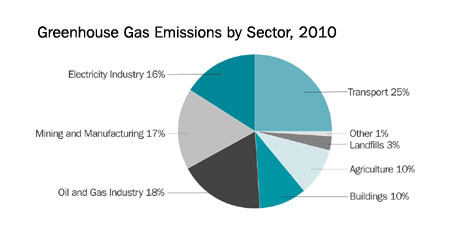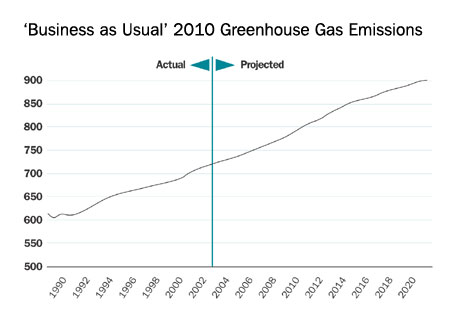ARCHIVED - Sustainable Development
Information Archived on the Web
Information identified as archived on the Web is for reference, research or recordkeeping purposes. It has not been altered or updated after the date of archiving. Web pages that are archived on the Web are not subject to the Government of Canada Web Standards. As per the Communications Policy of the Government of Canada, you can request alternate formats. Please "contact us" to request a format other than those available.
Sustainable Development Strategy
Moving Forward
Issues
Taking action on climate change
Climate change poses a threat to sustainable development, in Canada and globally. There is compelling scientific evidence that human activity, particularly activities associated with energy use and deforestation, is affecting the world’s climate by accelerating the concentration of greenhouse gases (most importantly, carbon dioxide) in our atmosphere. There is general agreement that the Earth’s average surface temperature will increase by at least 1.4 degrees Celsius by 2100, and possibly by as much as 5.8 degrees. The increase in average temperature will affect climate around the globe, including shifts in temperature, wind and precipitation patterns, and the frequency of severe weather events.
Canadians may already be feeling the effects of climate change, from hotter summers to insect infestations in British Columbia’s forests, to changing permafrost conditions in the North. While singular events, such as a heat wave, storm or forest fire, cannot be said to be caused by climate change, they can be interpreted as part of a pattern of increasing numbers of severe events, which is linked to climate change. Understanding climate change, and taking action to reduce emissions and adapt to the impacts we won’t be able to avoid, are crucial to safeguarding the long-term well-being of Canadians.
To make progress towards meeting our international commitments, Canada needs to take action on many fronts.
Canada ratified the Kyoto Protocol in December 2002, making the commitment to reduce greenhouse gas emissions to six percent below 1990 levels by 2008-2012. However, the most recent ‘business as usual’ projections show that, if no action is taken, there will be a steady increase in greenhouse gas emissions for 2008-2012.
Taking action to mitigate climate change is a challenge for all Canadians. NRCan has been working to decrease Canada’s greenhouse gas emissions since the early 1990s. These efforts contributed to the 1990s’ trend towards increased energy efficiency in Canada. Between the negotiation of the Kyoto Protocol in 1997 and its ratification in 2002, the federal government introduced a series of measures aimed at enhancing our efforts to reduce emissions. Over that five years, $1.7 billion was allocated in activities such as climate science, mitigation measures, and technology development—many of these are under NRCan’s responsibility.
The Climate Change Plan for Canada was developed to guide the Kyoto ratification decision. It proposes targeted measures to reduce greenhouse gas emissions in sectors such as housing, commercial and institutional buildings, and transportation. The approach also proposes targets for large final emitters (such as the oil and gas sectors, electricity generation, and mining and manufacturing), as well as a further investment in technology and innovation to help develop long-term solutions to climate change. In 2003, the Government of Canada announced new climate change funding of $2 billion to start implementing the approach over the next five years. A series of new mitigation measures are being introduced, along with a technology and innovation initiative. With this investment, NRCan remains at the centre of federal efforts to reduce greenhouse gas emissions.
There are many side benefits of actions taken to reduce greenhouse gas emissions. Most of the options for increasing eco-efficiency also reduce pollution, improving air quality and the health of many Canadians. Advanced research and development on renewable and clean energy sources and assistance in bringing these solutions to market will increase their availability and use, creating new employment and export opportunities, enhancing the success of Canada’s leading-edge businesses. Investing in research to further our knowledge of carbon storage in the environment and innovative approaches to enhance carbon sequestration could lead to the development of unique world-leading climate change mitigation strategies.

Canada will see increasing environmental, social and economic impacts from climate change during this century; we need to be prepared.
Even if Canada achieves its emissions reduction targets, the impacts of climate change will continue to be felt for many decades and adaptation will be required. While reducing emissions is essential to slow down the anticipated impacts and may reduce their severity, Canadians will still need to adapt to climate change. While concentrated efforts have greatly increased our understanding of the anticipated impacts of climate change, the process of building capacity in this relatively new, cross-cutting field (impacts and adaptation research) has just begun.
Collaboration among governments, academics, and the private sector, along with public participation and input, will improve Canada’s ability to adapt to climate change. One of the key tasks will be to expand the assessment of vulnerabilities to climate change to all areas of Canada, particularly the North where a greater increase in average temperature is expected. NRCan has a coordinating role in advancing Canada’s preparedness in this area, and a specific responsibility to enhance disaster response preparedness by providing knowledge and expertise related to natural hazards. For example, the predicted increase in heavy rainfall events could lead to a corresponding increase in the frequency of landslides, putting critical infrastructure at greater risk. Improving infrastructure resilience and enhancing disaster response preparedness in population centres makes Canadian communities stronger and safer. Accurate predictions of anticipated impacts may provide industries and communities with time to avoid some potential problems, make plans for effectively coping with others, and take advantage of new opportunities such as those provided by expanding forest ranges.
Page details
- Date modified:



